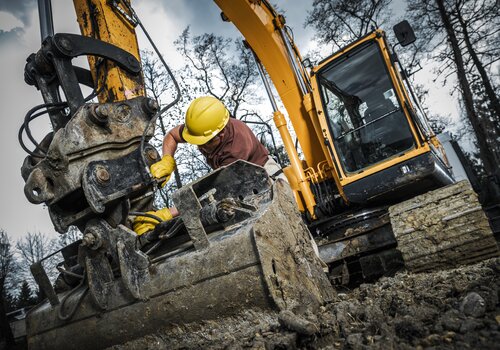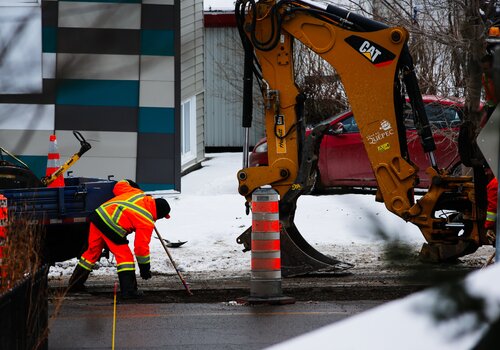Construction that is focused on environmentally friendly stream and wetland restoration is a very niche market because the work is extremely specialized. The work involves offsetting environmental impacts created by new infrastructure and development. The restoration and work take place in impacted watersheds.
The restoration occurs where streambeds or wetlands have been damaged and impacted during construction, development, destruction or a disturbance – whether created by human or natural activity.
One of the leading environmental contractors in the U.S. is Wright Contracting. Based in Siler City, NC – about 30 minutes west Raleigh, NC, the company was established in 2008 by Joe Wright.
“There are a few companies that who dabble in environmental construction,” he notes, “ but that is all we do.”
Environmental construction and management is a unique line of work that is inherently different than typical construction work, explains Wright. “It is a mixture of logging, demolition, quarries, landscaping, earthmoving and utilities. Add water and blend it all together.
“It is art form that requires very skilled machine operators because you are trying to recreate something that exists naturally. That is exceedingly difficult to do when you have engineers that like straight lines and are limited by the constraints of CAD (computer-aided design).”
“Our work is not something any contractor can just decide to do as a sideline to its standard construction work. You cannot just switch from another type of construction to stream and wetland restoration. It requires a great deal of training and years of on-the-job training. It is an extremely hard market to break into and sustain as a business.”
Good Odds
Wright did not grow up wanting to get into stream and wetland restoration. A native of western North Carolina, his dream was be a fighter pilot. Going to North Carolina State University, studying biological and agricultural engineering and being in Air Force ROTC, “through faith in the Lord my pathway became clear. Being in the dirt was my passion and ultimately my career.
“There were about 40 of us studying environmental restoration,” recalls Wright. “I was the only one that wanted to be an environmental contractor. I thought that was pretty good odds.”
Finishing college, his love of stream and wetlands restoration gave him the impetus to form Wright Contracting. It quickly established itself as a go-to company in the region for the work.
“We started out doing small projects and work that other companies would not do and quickly built up a solid resume. We have had steady growth.”
Military Mindset
Wright says his company takes a Special Forces approach to its work. It establishes the mission requirements, plans its attack, forms a very cohesive team, gathers all the tools, equipment and technology needed, then surgically carries out the mission as quickly and safely as possible.
“We are very big on technology, automated GPS capable machines and anything else that will help increase worksite productivity and enable precise work.”
The company uses an array of specialized equipment, especially low ground pressure equipment. These are heavy equipment designed to spread the weight of the equipment over a larger area. In addition to causing little impact to the ground, this allows the equipment to perform work in soft ground and wetlands and move across terrain that is too soft for regular heavy equipment.
Constant Search for New Technology
Along with reading trade journals and searching the Internet, Wrights says attendance at CONEXPO-CON/AGG – North America's largest construction trade show – has helped his company keep an eye on emerging technologies and software solutions and look for ways take advantage of them.
By way of example, it was at one CONEXPO-CON/AGG that he learned about the Engcon Tiltrotator. It is an excavator attachment with a “flexible wrist” that allows performing a variety of tasks from any angle, often without the need to reposition the excavator. That, notes Wright, results in higher productivity and less wear and tear on equipment.
“The less impact, the better we do things and faster we are, the better.”
At another CONEXPO-CON/AGG, Wright was introduced to HCSS Software. It does estimating, project management, fleet management, timecards, job costs and project management for heavy construction. The software enabled the company improve business efficiency, operations, productivity and profitability.
He also employs technology to monitor field operations from the office.
“We keep growing into new technology but it is difficult to keep up with it because technology is changing so fast,” he says. “By the time you get good at, it has changed.”
Wright is also always pursing technology to reduce fatigue and stress on the company’s workforce because environmental construction is so labor intensive.
“We are always looking for something – a new technology, a piece of equipment, software – that gives us an edge or allows us to work more efficiently in increasingly more difficult areas.”
Finding Skilled Workers
Like so many other companies in the construction industry, “it is difficult to find the right people, particularly for our kind of work because it is so different from regular construction. For every 4 or 5 people we look at, we might find one that is able to do what we do.”
He says the company seeks people that have a good attitude, have the capacity to do the work, are passionate about stream and wetland restoration, are willing to learn and are okay with doing a significant amount of traveling and being away from home.
Also important is “their willingness to be part of a team. At Wright Contracting, we are all working for each other and that makes a difference. It is a shared vision and responsibility for us all to be the best at what we do.”
The Reward
“From an environmental perspective, we are protecting what we have naturally,” says Wright. “If we are not producing a good product it shows. Our product is scrutinized for 10 years after the work has been completed. It is not like we build a building and walk away.
“The reward for all our hard work is that 50 years from now, you have a pristine product that nobody knows was touched by human hands.”
Join more than 40,000 industry peers who receive construction industry news and trends each week. Subscribe to CONEXPO-CON/AGG 365.












